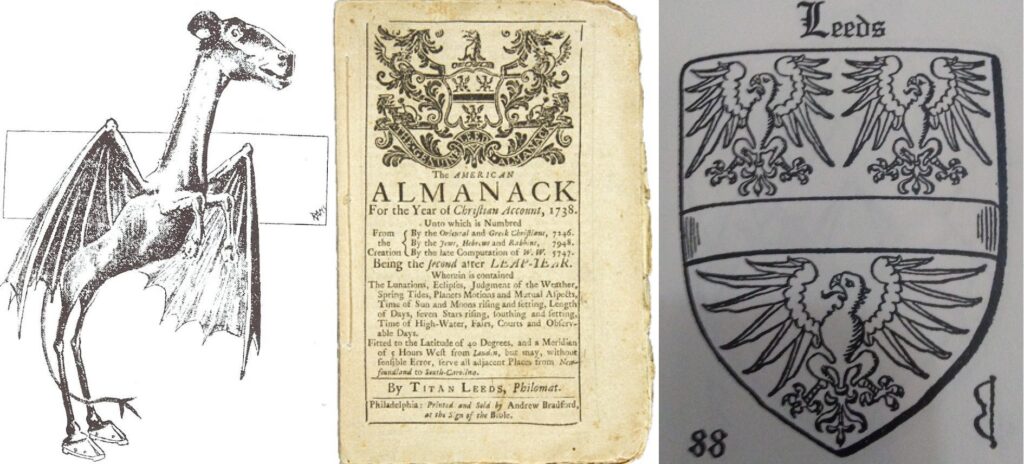By Tyler Robinson
According to a story told in the Pine Barrens of New Jersey, Commodore Stephen Decatur, the Naval hero most famous for his daring 1804 raid on the harbor of Tripoli, encountered the cryptid popularly known as the Jersey Devil during a visit to the Hanover Mill Works, firing a cannonball at the creature to little effect. The origin of this anecdote is unclear, but Decatur is not the only prominent figure from military history alleged to have crossed paths with the Devil of the Pines. Napoleon Bonaparte’s own brother, Joseph, claimed to have encountered the creature on a hunting excursion from the remote New Jersey manor where he resided for a time after being ousted from the Spanish throne.
According to a popular folktale dating back to the 18th century, the creature that would come to be known as the New Jersey Devil was born the cursed 13th child of a witch named Mother Leeds before fleeing into the pines. This figure is often associated with Deborah Leeds, a real historical figure who’s husband Japhet Leeds recorded 12 children in his will.
A number of more rational explanations for the origin of the Leeds Devil myth have also been offered. Some amalgamation of these factors most likely enabled the narrative to gain traction.
One explanation for the Leeds family’s sinister reputation derives from the cover of the Leeds Almanack under the stewardship of one Titan Leeds, who prominently emblazoned the publication with the Leeds family heraldry in blotchy ink. This has been described by Bryan Regal and Frank J. Esposito in their book The Secret History of the Jersey Devil as featuring 3 wyverns, dragons on two legs bearing a strong resemblance to the prototypical description of the Leeds devil. The New England Heraldry Society provides a contradictory description of the Leeds Heraldry as featuring eagles rather than dragons. Whatever the original intention, a misinterpretation of the blurry crest featured on the almanack’s cover may have influenced the comically grotesque description of the creature in the original tale.
A related theory draws upon a feud between Titan Leeds and a sardonic upstart Philadelphia almanack maker named Benjamin Franklin, who mocked Leeds for his adherence to astrological portents, insisting they revealed the date of Titan’s death as some years past, thereby indicating that Mr. Leeds was an unholy revenant.
The demonization of the Leeds family may also be attributable to its history of aristocratic cronyism dating back to the 17th century. Daniel Leeds, a lord proprietor of New Jersey and founder of the family almanac, was complicit in the scandalous actions of Governor Cornbury and earned the moniker of “Satan’s Harbinger” from his political and theological opposition, the Quakers. Furthermore, as Surveyor General of West Jersey, he was accused of using the office to personally enrich himself.
Geography and geology also played a role in drawing the fledgling U.S. Navy to the area. The bog iron of the Pinelands was a vital strategic resource in 18th century America, and the people of this coastal wetland had a long history of privateering even before the Revolutionary War. This maritime culture is also reflected in local folklore, which features a ghostly member of Captain Kidd’s pirate crew sometimes said to accompany the Leeds Devil.
Littoral areas like the Pinelands prominently feature in folkloric beliefs, symbolically representing the borders between worlds. Moreover, the alien environment faced by colonists in the Americas would certainly enhance such concern for the unknown. It is perhaps unsurprising, then, that this area played host to both a strong military presence and an unusually enduring bogey man.
Today, the Jersey Devil seems to have come full circle from its origin as a symbol of Loyalist decadence. It is now featured in the heraldry of the United States armed forces, serving as a mascot for the 177th Fighter Wing of the New Jersey Air National Guard. It also, somewhat more famously, became the namesake of the Jersey Devils hockey team under the ownership of noted naval engineer Dr. John J. McMullen, namesake of the USNA McMullen Naval History Symposium.
Tyler Robinson graduated with an MLitt in International Security Studies from the University of St Andrews in 2018. He has also contributed reports on emerging technologies and geopolitical threats for OODA LLC.




Richard Demuth